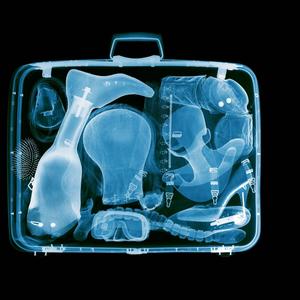TRAVELOGUES
NEWYORK,NY
Travelogues is a permanent public artwork conceived for two sterile corridors that link passenger gates to passport control in the international arrivals terminal at John F. Kennedy International Airport. The sterile corridor is a space peculiar to the regulatory nature of contemporary air travel. It is a featureless “nonplace” between two jurisdictions: the place left behind and the one to be entered. It is a space in which diverse travelers—tourists returning home, visitors and business travelers entering the country, refugees on the move, and immigrants arriving to begin a new life—share the status of world citizens in limbo. Defined by one-directional movement—walking, rushing, or effortlessly gliding on the people mover—the corridor is a space to pass through, not stop.
Thirty-three backlit lenticular screens are evenly spaced along the 1,800 linear feet of the building’s two corridors. Each screen holds two seconds of action that is animated by the speed of the moving viewer. The space between screens acts as a time lapse: each animation is succeeded by a ten-second interval on the approach to the next screen. The succession of lenticular screens builds a sequence of micromovies. Thus the traveler walking down the corridor inadvertently engages a real-time moving-picture narrative delivered in tiny installments.
The common storytelling vehicle in each micromovie is a suitcase, a microcosm of one’s identity, packed with narratives to unravel. Suitcases are chosen at random from travelers in the airport. The cases are X-rayed, reveal contents that trigger flashbacks of travel experiences.
The lenticular screens are able to create short filmic sequences. Essentially, a lenticular screen is an extruded lens in sheet form. When used in conjunction with an offset printing process, it can produce an image with depth and motion. The ribbed sheet consists of hundreds of optical-quality cylindrical lenses. A number of interleaved parallel images are compressed beneath each rib, or lens. As the eye moves across the image, the lens refracts the images beneath it so that a sequence of images is revealed. The lenticular’s 3-D effect is generated by the same principle that distinguishes stereoscopy: each eye sees a different view because each eye is at a different angle to the lens. The effect of animation is generated through the movement of the eye past the lens, exposing sequential frames of animation.
At the end of each sequence, we return to the X-rayed suitcase and traveler disappearing into the crowd.
| Location JFK Airport, New York, United States |
| Team | Elizabeth Diller,Ricardo Scofidio,Matthew Johnson,Deane Simpson,and Nicholas de Monechaux |







